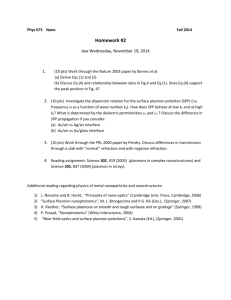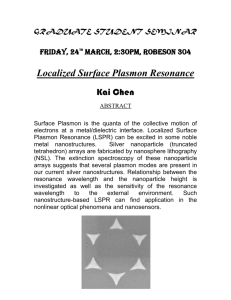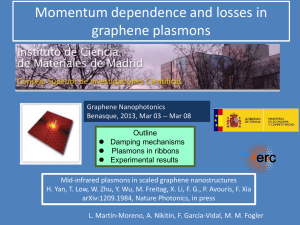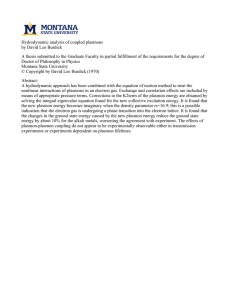Experimental and theoretical studies of plasma resonance and the electronic
advertisement
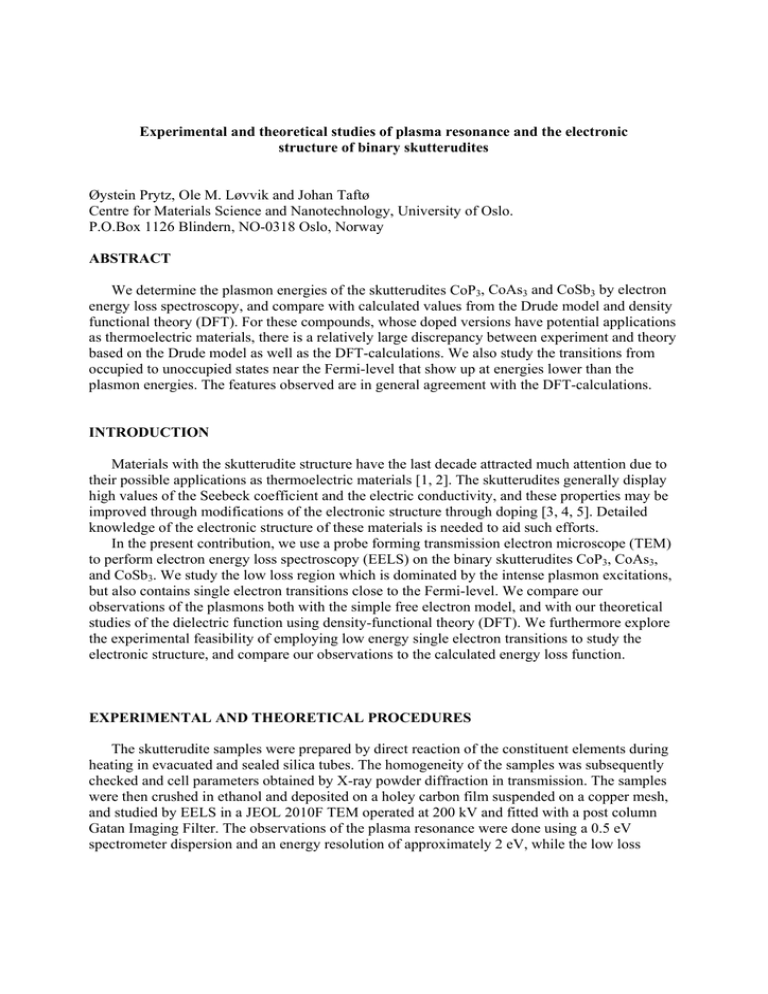
Experimental and theoretical studies of plasma resonance and the electronic structure of binary skutterudites Øystein Prytz, Ole M. Løvvik and Johan Taftø Centre for Materials Science and Nanotechnology, University of Oslo. P.O.Box 1126 Blindern, NO-0318 Oslo, Norway ABSTRACT We determine the plasmon energies of the skutterudites CoP3, CoAs3 and CoSb3 by electron energy loss spectroscopy, and compare with calculated values from the Drude model and density functional theory (DFT). For these compounds, whose doped versions have potential applications as thermoelectric materials, there is a relatively large discrepancy between experiment and theory based on the Drude model as well as the DFT-calculations. We also study the transitions from occupied to unoccupied states near the Fermi-level that show up at energies lower than the plasmon energies. The features observed are in general agreement with the DFT-calculations. INTRODUCTION Materials with the skutterudite structure have the last decade attracted much attention due to their possible applications as thermoelectric materials [1, 2]. The skutterudites generally display high values of the Seebeck coefficient and the electric conductivity, and these properties may be improved through modifications of the electronic structure through doping [3, 4, 5]. Detailed knowledge of the electronic structure of these materials is needed to aid such efforts. In the present contribution, we use a probe forming transmission electron microscope (TEM) to perform electron energy loss spectroscopy (EELS) on the binary skutterudites CoP3, CoAs3, and CoSb3. We study the low loss region which is dominated by the intense plasmon excitations, but also contains single electron transitions close to the Fermi-level. We compare our observations of the plasmons both with the simple free electron model, and with our theoretical studies of the dielectric function using density-functional theory (DFT). We furthermore explore the experimental feasibility of employing low energy single electron transitions to study the electronic structure, and compare our observations to the calculated energy loss function. EXPERIMENTAL AND THEORETICAL PROCEDURES The skutterudite samples were prepared by direct reaction of the constituent elements during heating in evacuated and sealed silica tubes. The homogeneity of the samples was subsequently checked and cell parameters obtained by X-ray powder diffraction in transmission. The samples were then crushed in ethanol and deposited on a holey carbon film suspended on a copper mesh, and studied by EELS in a JEOL 2010F TEM operated at 200 kV and fitted with a post column Gatan Imaging Filter. The observations of the plasma resonance were done using a 0.5 eV spectrometer dispersion and an energy resolution of approximately 2 eV, while the low loss single electron transitions were observed using a 0.2 eV dispersion and an energy resolution of 1.2-1.4 eV. The calculations were performed using density functional theory at the generalized gradient approximation (GGA) level. Structural relaxations and densities of states (DOS) were calculated using the Vienna ab initio Simulation Package (VASP) [6, 7]. The dielectric function ε (ω ) of the skutterudites was obtained from the Optic package of the WIEN2K code [8], and the energy loss function (ELF) was calculated as [9]: ELF ∝ Im(− ε 1 )= 2 2 2 ε (ω ) ε 1 + ε 2 (1) For VASP, the energy cutoff for the plane wave expansion was 500 eV, the k-point distances were less than 0.20 Å-1, the criterion for self-consistency was energy convergence within 10-5 eV, and spin polarization was allowed. For wien2k, the product RMTKmax = 7, the largest vector in the charge density Fourier expansion was Gmax = 14, and the number of k-points was 1000. RESULTS AND DISCUSSION Plasma resonance Figure 1a shows the low loss EEL spectra for the binary skutterudites. All the skutterudites show a sharp plasmon peak, and additional peaks associated with multiple plasmon excitations. This behaviour is very similar to that displayed by semiconductors and simple metals, while transition metals and their oxides usually display only a single broad plasmon. In the free electron Drude model, the plasmon energy is given by E pD = hω pD where ω pD is the frequency of the plasma oscillation given by [9]: ω pD = ne 2 ε 0 m0 (2) Here, n is the density of valence electrons, e and ε0 are the elementary electric charge and the permittivity of free space, while m0 is the free electron mass. Table I gives the experimentally determined plasmon energies for the skutterudites, along with the theoretically calculated energy found using equation 2 and assuming 3 valence electrons for Co and 5 electrons for P, As and Sb. The table also gives the deviation of the experimental value from the theory. While the Drude model usually gives an adequate estimate of the plasmon energy for the simple metals and semiconductors, we note that the plasmon energy of the skutterudites is raised significantly above the theoretical value. Figure 1: Experimentally obtained EEL spectra from the low loss region of the skutterudites showing the sharp, well defined plasmons as well as secondary plasmons due to multiple scattering. The Zero Loss Peak extends above the figure. The calculated ELF shows prominent, sharp peaks associated with the plasma resonance, consistent with our observations in figure 1. The ELF is quite successful at predicting the plasmon energy of CoAs3 and to some degree also CoP3, but fails to give a good estimate for CoSb3, see table I. It should be noted that transition metals with many d-electrons often cause problems in the DFT calculations due to difficulties in handling exchange and correlation in strongly correlated systems. This may be part of the reason for the relatively large difference between the experimental and theoretical plasmon energies. Table I: Experimental plasmon energy E pexp for the three skutterudites. We also list the plasmon energy calculated from the Drude model, E pD , and the plasmon energy found from the ELF based on the dielectric function, E pDFT . E pexp /eV CoP3 21.51±0.04 CoAs3 20.09±0.06 CoSb3 16.85±0.07 E pD /eV Experimental deviation from Drude model E pDFT /eV Experimental deviation from DFT 20.77 18.94 16.36 +3.6 % +6.1 % +3.0 % 20.9 19.9 17.9 +2.6% +1.0% -5.9% Single electron transitions The intensity of the EEL spectrum associated with single electron transitions is approximately given by [10]: I ∝ ⟨ f | e ik ⋅r | i⟩ ≈ ⟨ f | ik ⋅ r | i⟩ (3) Here i and f designate the occupied initial and unoccupied final states. The momentum transfer is often sufficiently small that the dipole approximation is considered valid, in which case the intensity is given by the final part of equation 3. The final states are located a few eV above the Fermi-level and are sensitive to the atomic environment and the nature of the bonds occurring in the compound [10]. In comparison, the initial states may be located several hundred eV below the Fermi-level, and are then mainly atomic in nature, although a chemical shift may be observed depending on the atomic environment. In this work we wish to explore the feasibility of using low energy single electron transitions from initial states 0-10 eV below the Fermi-level in order to study the electronic structure of the skutterudites. Both the initial and final states of these transitions are located close to the Fermilevel, and thus influenced by the bonding in the material. These features may provide valuable information on the electronic structure of the material. In other words, we wish to examine the fine structure of the energy loss between the plasmon and the zero loss peak (ZLP). Single electron transitions are expected to have a rather low intensity compared to the ZLP and the sharp plasmons. In order to experimentally study the fine structure on the low energy side of the plasmons, we must first remove the intense zero loss peak. This is achieved by first obtaining an experimental ZLP profile outside the sample. This profile is then fitted to the ZLP observed in the spectrum of interest and subtracted, leaving only the inelastic component of the EEL spectrum [9]. When this procedure is performed on the EEL spectra obtained from CoP3, a peak is observed preceding the plasmon peak, see figure 3a. Subtracting the exponentially rising intensity of the plasmon, we are left with an energy loss intensity centered around 9 eV, see figure 3b. In thin samples, surface effects can have a significant influence on the EELS spectrum, causing the appearance of a so-called surface plasmon preceding the more intense bulk-plasmon [9]. At a first glance, one might suspect that this is the case observed in figure 3. However, the surface plasmons occur at energy equal to E pBulk / 2 which in the case of CoP3 is approximately 15.2 eV. We therefore conclude that this peak is not a surface plasmon, but rather due to single electron transitions of the valence electrons. Figure 3: a) Energy loss spectrum obtained from CoP3 with the ZLP subtracted, leaving only the inelastic contribution. The dashed line is a model based on an exponential fit to the rising intensity of the plasmon peak. b) The remaining intensity after the model in 3a has been subtracted; only intensity below approximately 20 eV is included. Figure 4a shows the observed EEL spectra for the three skutterudites with the ZLP removed. In each spectrum, we have also plotted a model of the exponentially rising intensity due to the onset of the plasmon. Figure 4b shows the calculated ELF for the three compounds, with the energy loss due to the plasmon apparent on the high energy part, and a trailing shoulder towards the low energy side. There are significant fine structures in this shoulder, which may provide information on the bonding of the skutterudites. Figure 4: a) Experimentally obtained energy loss spectra from the three skutterudites, with the zero loss peak subtracted. An exponential model of the rising intensity of the plasmon is included (dashed line). b) Low energy region of the theoretically calculated energy loss function for the three materials. Further experimental studies in combination with DFT calculations may reveal details of the density of states above and below the Fermi-level. Since these studies are done in a probe forming TEM, they can be performed at the nanometer scale. CONCLUSION We have studied the low loss region of the electron energy loss spectra of CoP3, CoAs3 and CoSb3. Our results are compared with DFT calculated energy loss functions. Interesting features in the 5-10 eV region are predicted in the DFT calculations and are also observed experimentally. By careful experiments, we expect to observe significant features that in combination with DFT may reveal important information on the electronic states near the Fermi-level. Furthermore, we have accurately measured the plasmon energies of the skutterudites, and discrepancies between theory and these experiments may provide valuable input in improving the DFT method, for example with regard to exchange and correlation effects. REFERENCES 1. C. Uher, Semiconductors and semimetals 69, 139 (2001). 2. G. Chen, M. S. Dresselhaus, G. Dresselhaus et al., International Materials Reviews 48, 45 (2003). 3. T. Caillat, J. Kulleck, A. Borshchevsky et al., Journal of Applied Physics 79, 8419 (1996). 4. T. Caillat, A. Borshchevsky and J.-P. Fleurial, Journal of Applied Physics 80, 4442 (1996). 5. A. Watcharapasorn, R. C. DeMattei, R. S. Feigelson et al., Journal of Applied Physics 86, 6213 (1999). 6. G. Kresse and J. Hafner, Phys. Rev. B 47, R558 (1993). 7. G. Kresse and J. Furthmüller, Phys. Rev. B 54, 11169 (1996). 8. P. Blaha, K. Schwarz, G. Madsen, D. Kvasnicka, and J. Luitz, WIEN2k, an Augmented Plane Wave + Local Orbitals Program for Calculating Crystal Properties. K. Schwarz, TU Wien, Austria. ISBN 3-9501031-1-2 (2001). 9. R. F. Egerton, Electron Energy Loss Spectroscopy in the Electron Microscope, 1st ed. (Plenum Press, New York, 1986). 10. C. C. Ahn (editor), Transmission Electron Energy Loss Spectrometry in Materials Science and the EELS Atlas, 2nd ed. (Wiley-VCH Verlag GmbH & Co. KGaA, Weinheim, 2004).
